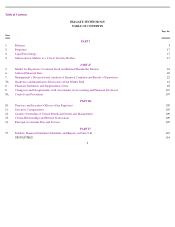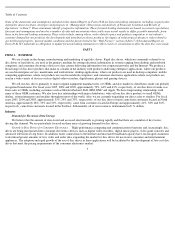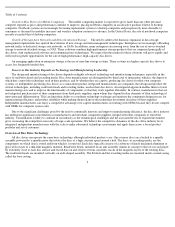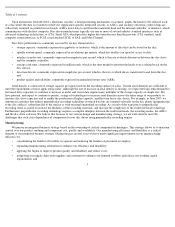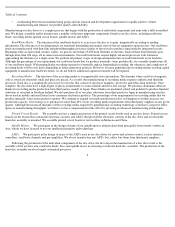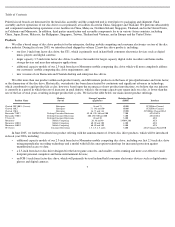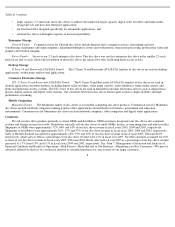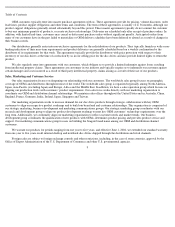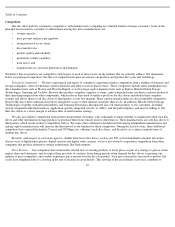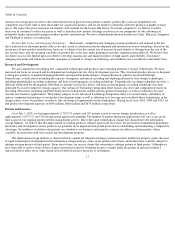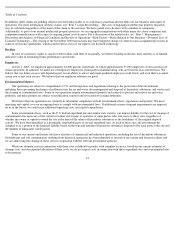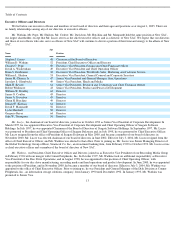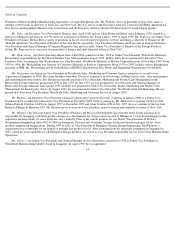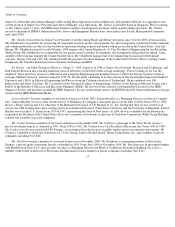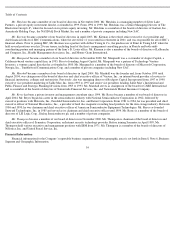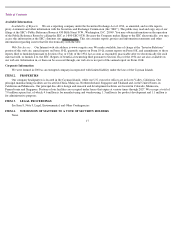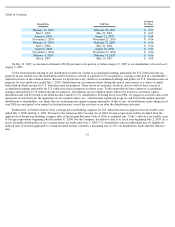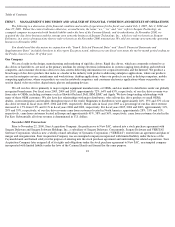Seagate 2004 Annual Report Download - page 14
Download and view the complete annual report
Please find page 14 of the 2004 Seagate annual report below. You can navigate through the pages in the report by either clicking on the pages listed below, or by using the keyword search tool below to find specific information within the annual report.
Table of Contents
In addition, other claims are pending which if resolved unfavorably to us could have a material adverse effect on our business and results of
operations. For more information on these claims, see “Item 3. Legal Proceedings.” The costs of engaging in intellectual property litigation
may be substantial regardless of the merit of the claim or the outcome. We have patent cross-licenses with a number of companies.
Additionally, as part of our normal intellectual property practices, we are engaged in negotiations with other major disc drive companies and
component manufacturers with respect to ongoing patent cross-licenses. For a discussion of the related risks, see “Item 7. Management’s
Discussion and Analysis of Financial Condition and Results of Operations—Risk Factors—Risks Related to Our Business—Potential Loss of
Licensed Technology—The closing of the November 2000 transactions may have triggered change of control or anti-assignment provisions in
some of our license agreements, which could result in a loss of our right to use licensed technology.”
Backlog
In view of customers’ rights to cancel or defer orders with little or no penalty, we believe backlog in the disc drive industry is of limited
indicative value in estimating future performance and results.
Employees
At July 1, 2005, we employed approximately 44,000 persons worldwide, of which approximately 35,000 employees were located in our
Asian operations. In addition, we make use of temporary employees, principally in manufacturing, who are hired on an as-needed basis. We
believe that our future success will depend in part on our ability to attract and retain qualified employees at all levels, and even then we cannot
assure you of any such success. We believe that our employee relations are good.
Environmental Matters
Our operations are subject to comprehensive U.S. and foreign laws and regulations relating to the protection of the environment,
including those governing discharges of pollutants into the air and water, the management and disposal of hazardous substances and wastes and
the cleanup of contaminated sites. Some of our operations require environmental permits and controls to prevent and reduce air and water
pollution, and these permits are subject to modification, renewal and revocation by issuing authorities.
We believe that our operations are currently in substantial compliance with all environmental laws, regulations and permits. We incur
operating and capital costs on an ongoing basis to comply with environmental laws. If additional or more stringent requirements are imposed
on us in the future, we could incur additional operating costs and capital expenditures.
Some environmental laws, such as the U.S. federal superfund law and similar state statutes, can impose liability for the cost of cleanup of
contaminated sites upon any of the current or former site owners or operators or upon parties who sent waste to these sites, regardless of
whether the owner or operator owned the site at the time of the release of hazardous substances or the lawfulness of the original disposal
activity. We have been identified as a potentially responsible party at several superfund sites. At each of these sites, the government has
assigned to us a portion of the financial liability based on the type and amount of hazardous substances disposed of by each party at the site and
the number of financially viable parties.
Some of our current and former sites have a history of commercial and industrial operations, including the use of hazardous substances.
Groundwater and soil contamination resulting from historical operations has been identified at several of our current and former facilities and
we are addressing the cleanup of these sites in cooperation with the relevant government agencies.
While our ultimate costs in connection with these sites is difficult to predict with complete accuracy, based on our current estimates of
cleanup costs and our expected allocation of these costs, we do not expect costs in connection with these superfund sites and contaminated sites
to be material.
12


